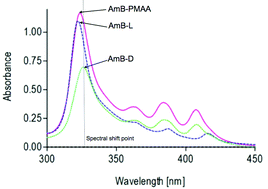Poly(methacrylic acid) complexation of amphotericin B to treat neglected diseases†
Abstract
Amphotericin B (AmB) is used to treat a neglected disease called visceral leishmaniasis (VL). We hypothesised that direct non-covalent association of AmB with poly(methacrylic acid) (PMAA) would replicate many of the properties of liposomal AmB (AmB-L), which is more efficacious than micellar AmB (AmB-D). Water-soluble AmB–PMAA complexes with AmB loadings ranging from ∼20 to 45% were reproducibly prepared. The AmB in the PMAA complex displayed similar aggregation properties to the AmB within AmB-L. The AmB–PMAA complex displayed low heamolytic properties while maintaining in vitro activity against Leishmania donovani amastigotes with no macrophage toxicity observed at an IC50 of 0.043 (±0.003) μM. AmB–PMAA complexes were well tolerated in vivo at a total dose of 6 mg kg−1 and both the complex (2.2 mg kg−1 AmB) and AmB-L (2.5 mg kg−1 AmB) achieved greater than 90% parasite inhibition in vivo after a single dose against L. donovani in HU3 infected BALB/c mice.


 Please wait while we load your content...
Please wait while we load your content...